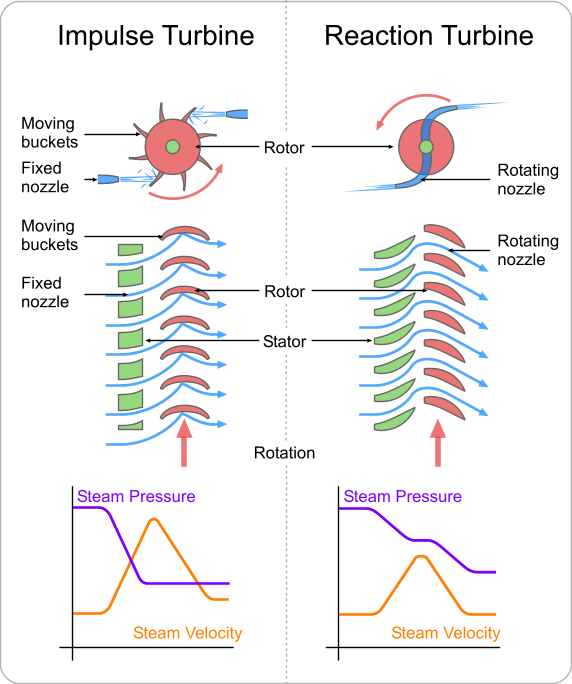Designed and developed by the China Marine Engineering Design and Research Institute (MARIC), the series is currently being collaborated with the French Bureau of Shipping (BV) for a thorough structural inspection.
The series is 399 meters long, 54 meters wide and 16 meters draught. The series is designed as a single propeller and is equipped with a 69 MW 2-stroke electronically controlled engine with a maximum speed of over 23 knots. The first ship will start cutting steel plates next year and is expected to be delivered in 2015.
A reaction turbine is a type of Steam Turbine that works on the principle that the rotor spins, as the name suggests, from a reaction force rather than an impact or impulse force.
In a reaction turbine there are no nozzles to direct the steam like in the impulse turbine.
Instead, the blades that project radially from the outer edge of the rotor are shaped and mounted so that the shape between the blades, created by the cross-section, create the shape of a nozzle. These blades are mounted on the revolving part of the rotor and are called the moving blades.
The fixed blades, which are the same shape as the moving blades, are mounted to the outer casing where the rotor revolves and are set to guide the steam into the moving blades. Below is a simple diagram of reaction turbine blades:
Reaction Turbine Principle:
In the case of reaction turbine, the moving blades of a turbine are shaped in such a way that the steam expands and drops in pressure as it passes through them. As a result of pressure decrease in the moving blade, a reaction force will be produced. This force will make the blades to rotate.

Reaction Turbine Working:
A reaction turbine has rows of fixed blades alternating with rows of moving blades. The steam expands first in the stationary or fixed blades where it gains some velocity as it drops in pressure. Then enters the moving blades where its direction of flow is changed thus producing an impulse force on the moving blades. In addition, however, the steam upon passing through the moving blades, again expands and further drops in pressure giving a reaction force to the blades.
This sequence is repeated as the steam passes through additional rows of fixed and moving blades.
Note that the steam pressure drops across both the fixed and the moving blades while the absolute velocity rises in the fixed blades and drops in the moving blades.
The distinguishing feature of the reaction turbine is the fact that the pressure does drop across the moving blades. In other words, there is a pressure difference between the inlet to the moving blades and the outlet from the moving blades.
Special Aspects of Reaction Turbines
- There is a difference in pressure across the moving blades. The steam will, therefore, tend to leak around the periphery of the blades instead of passing through them. Hence the blade clearances as to maintain as minimum as possible.
- Also, due to the pressure drop across the moving blades, an unbalanced thrust will be developed upon the rotor and some arrangement must be made to balance this.
Reaction Steam Turbine
Shandong Qingneng Power Co., Ltd. , http://www.qnpturbines.com
